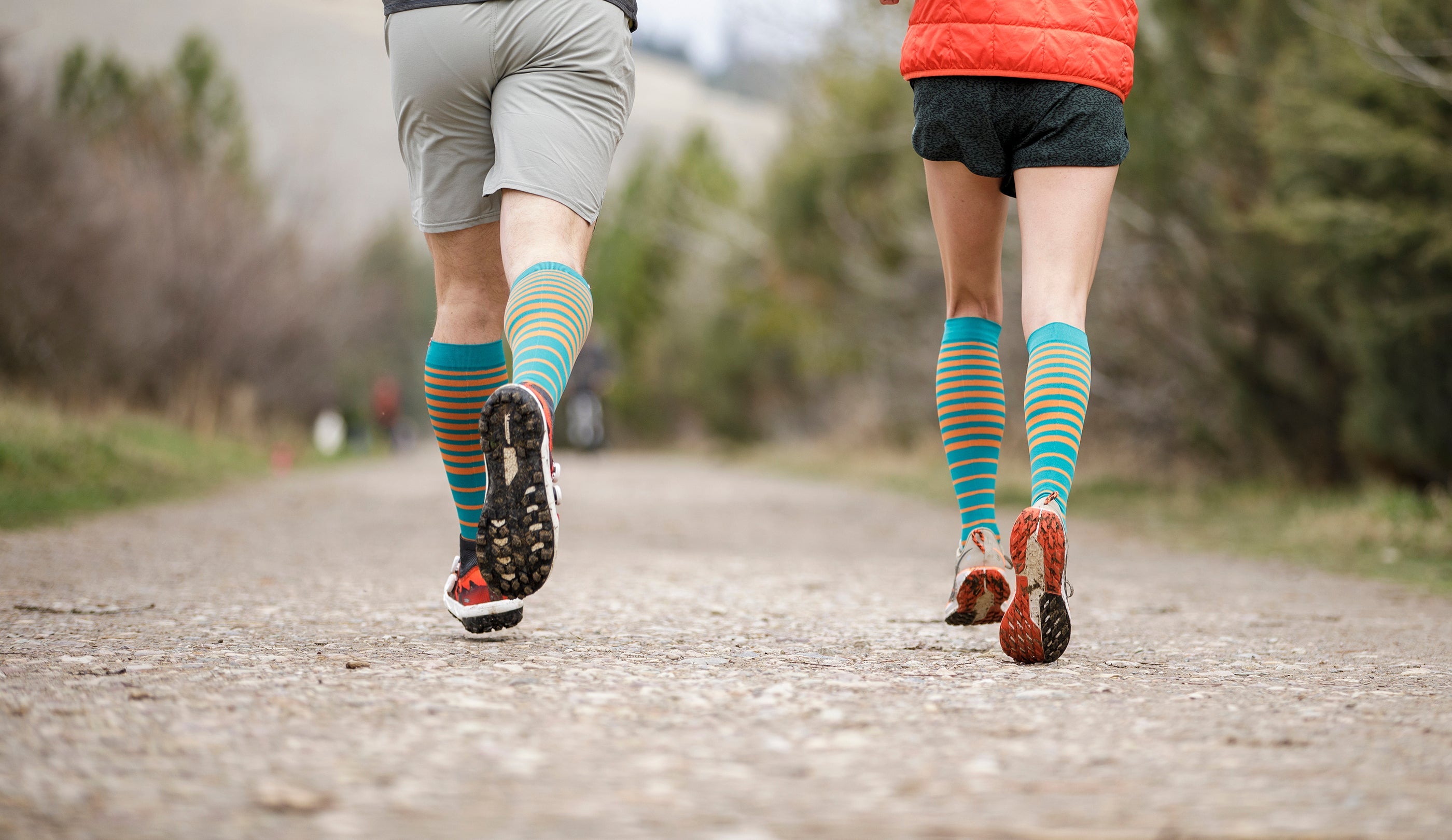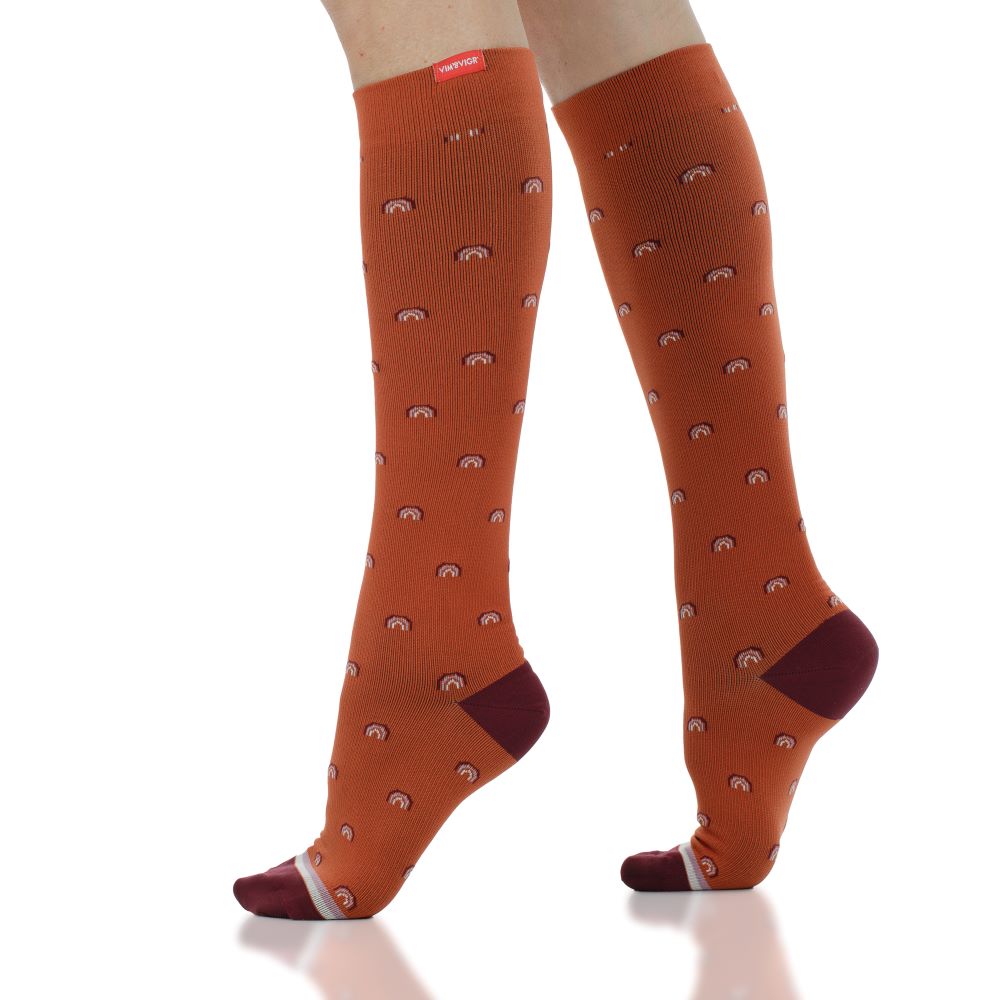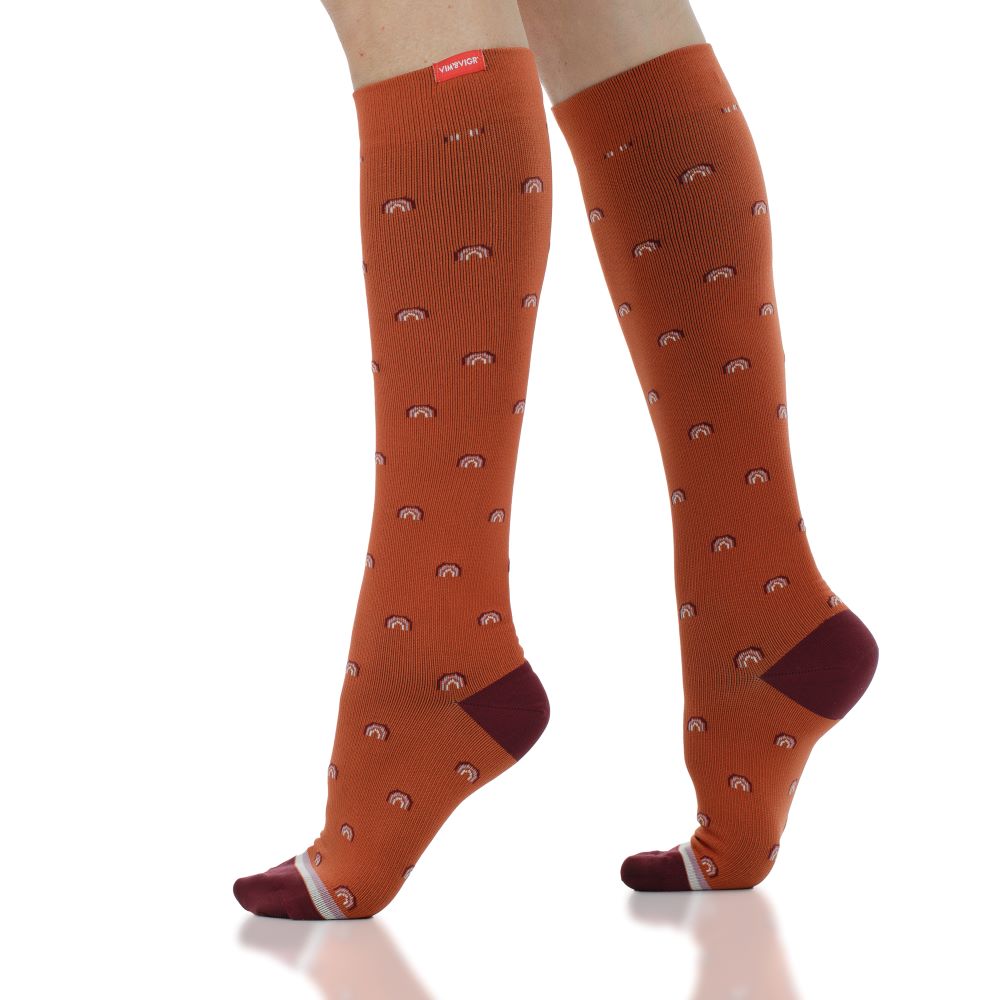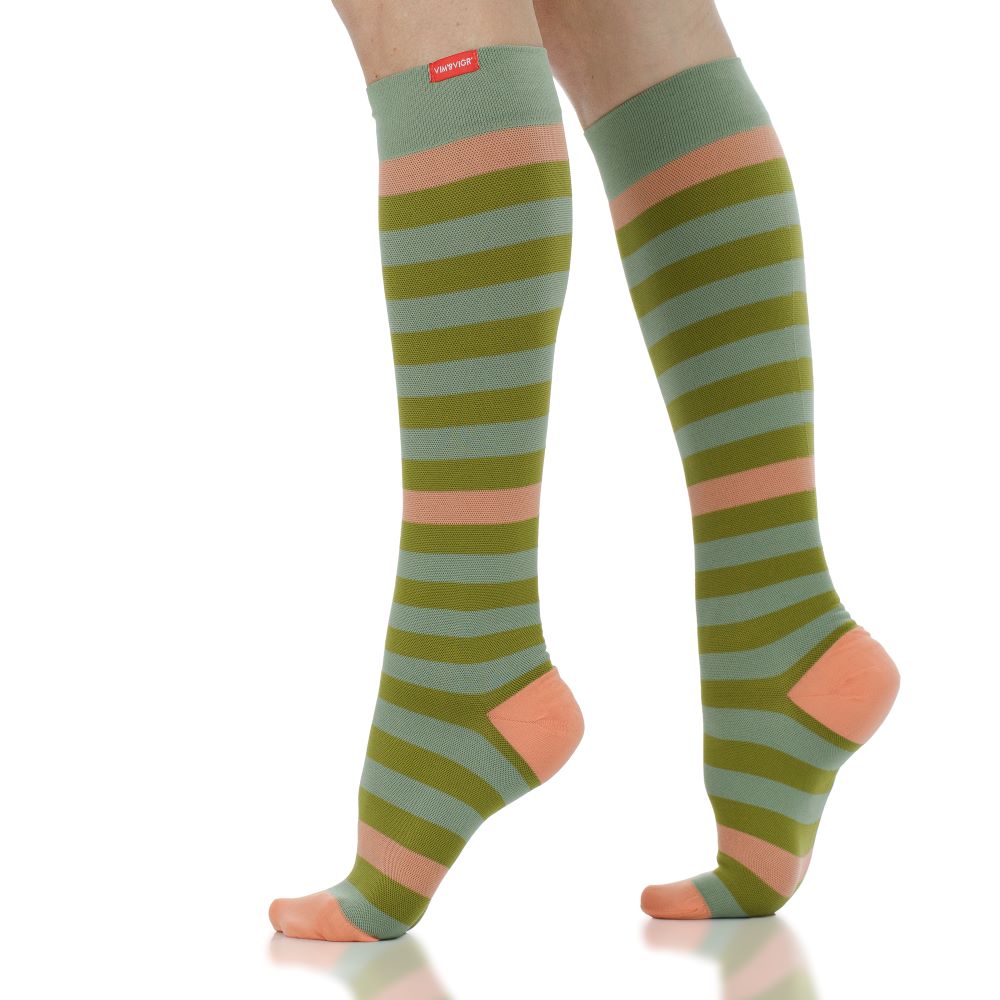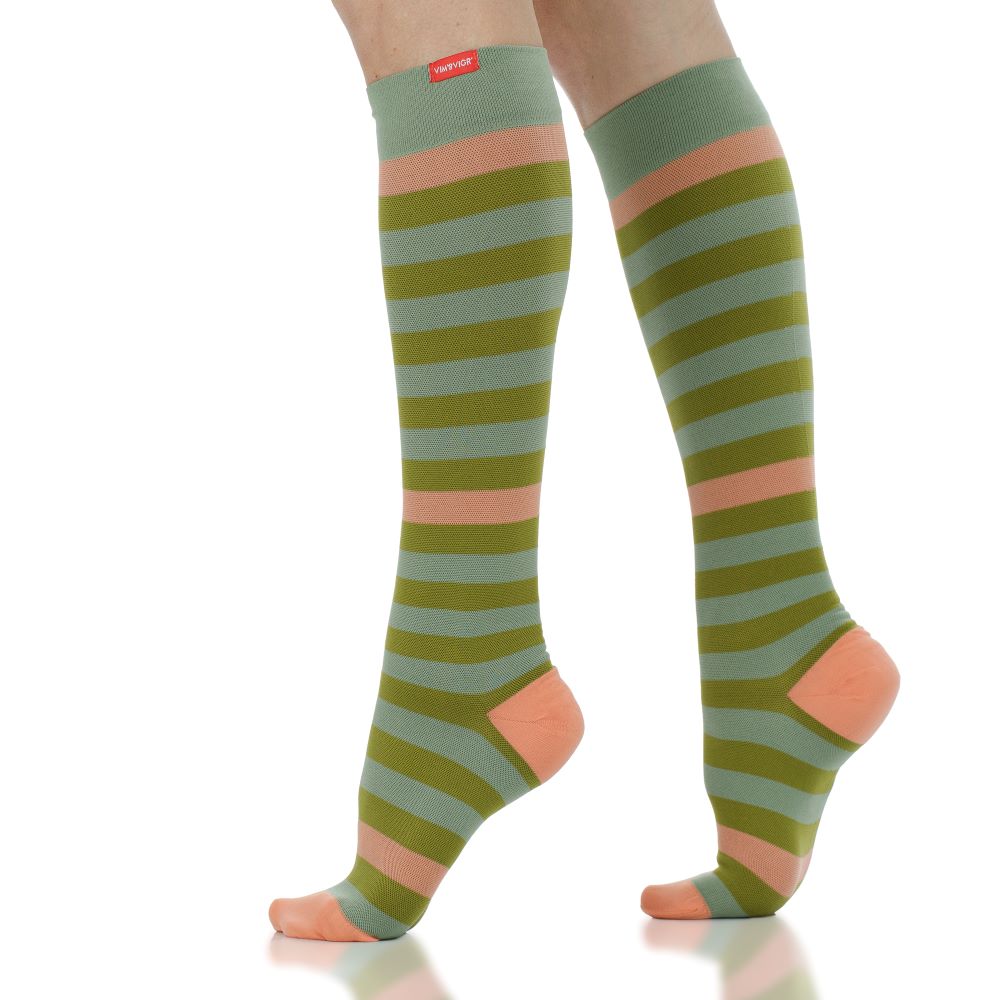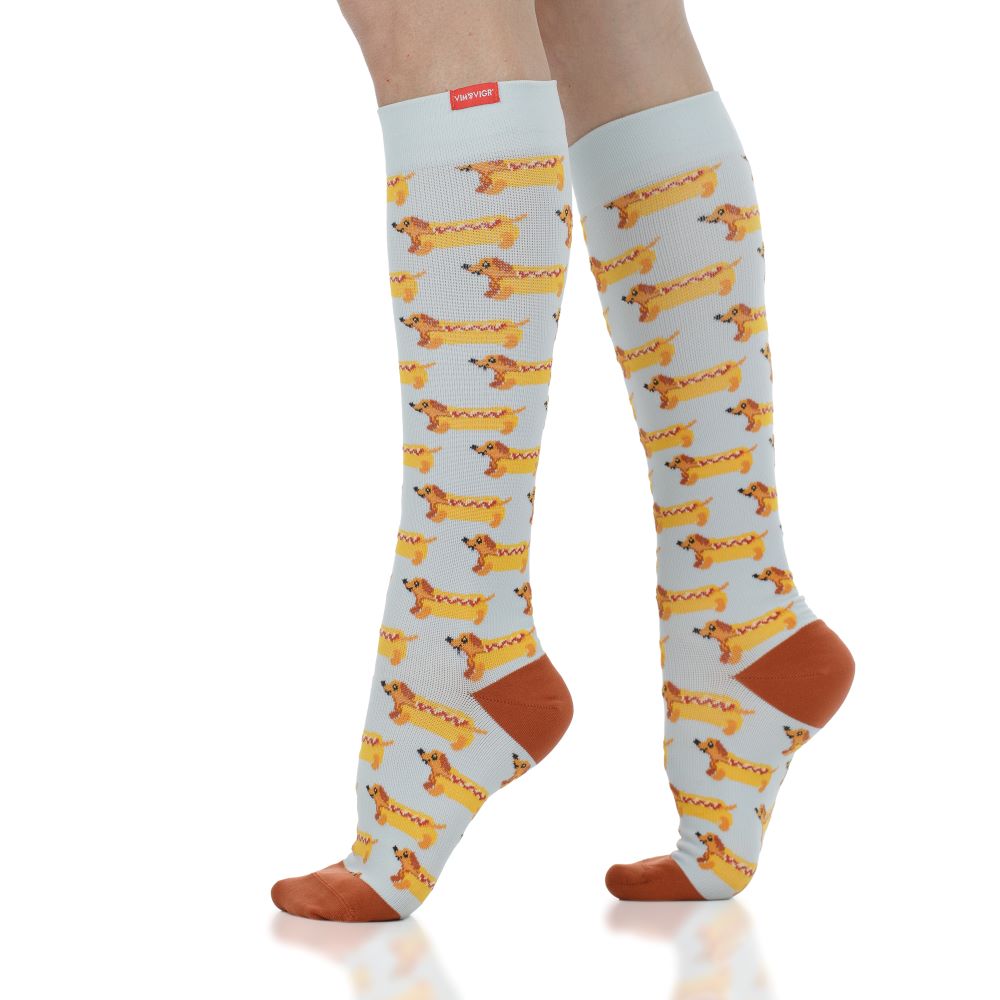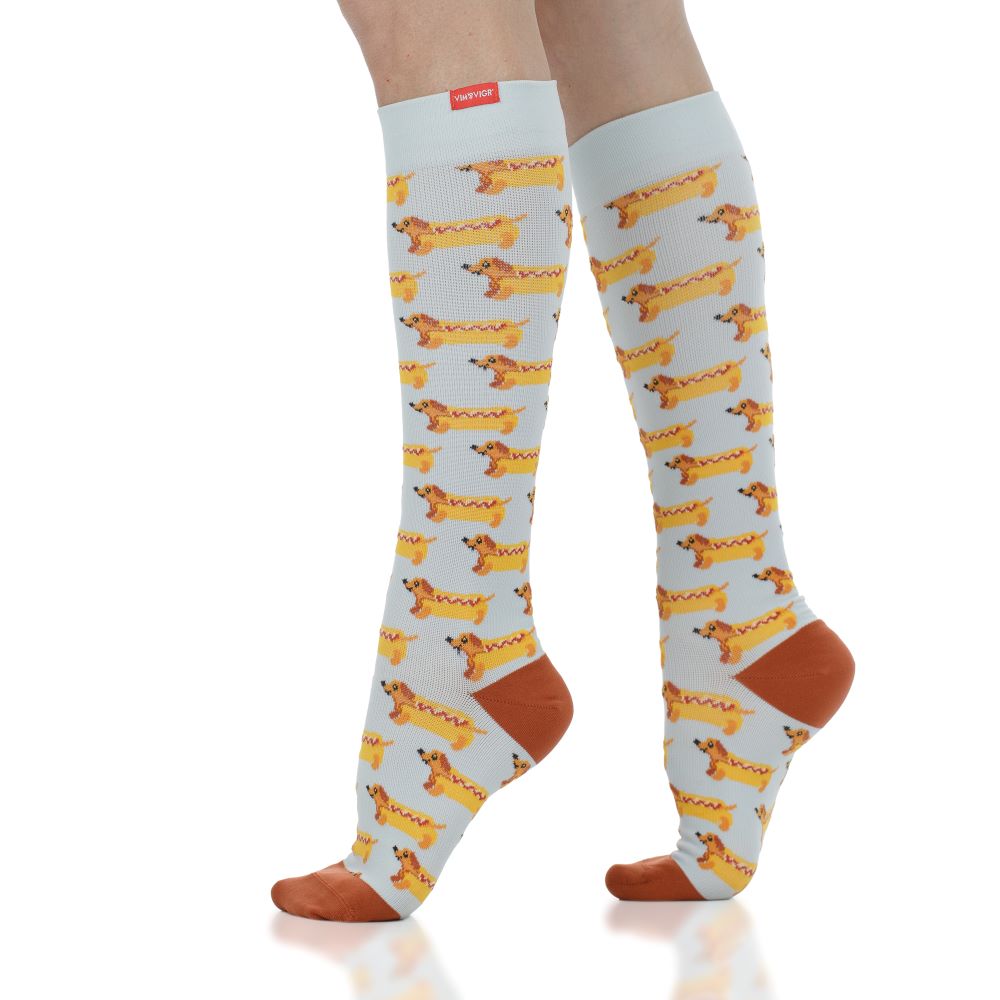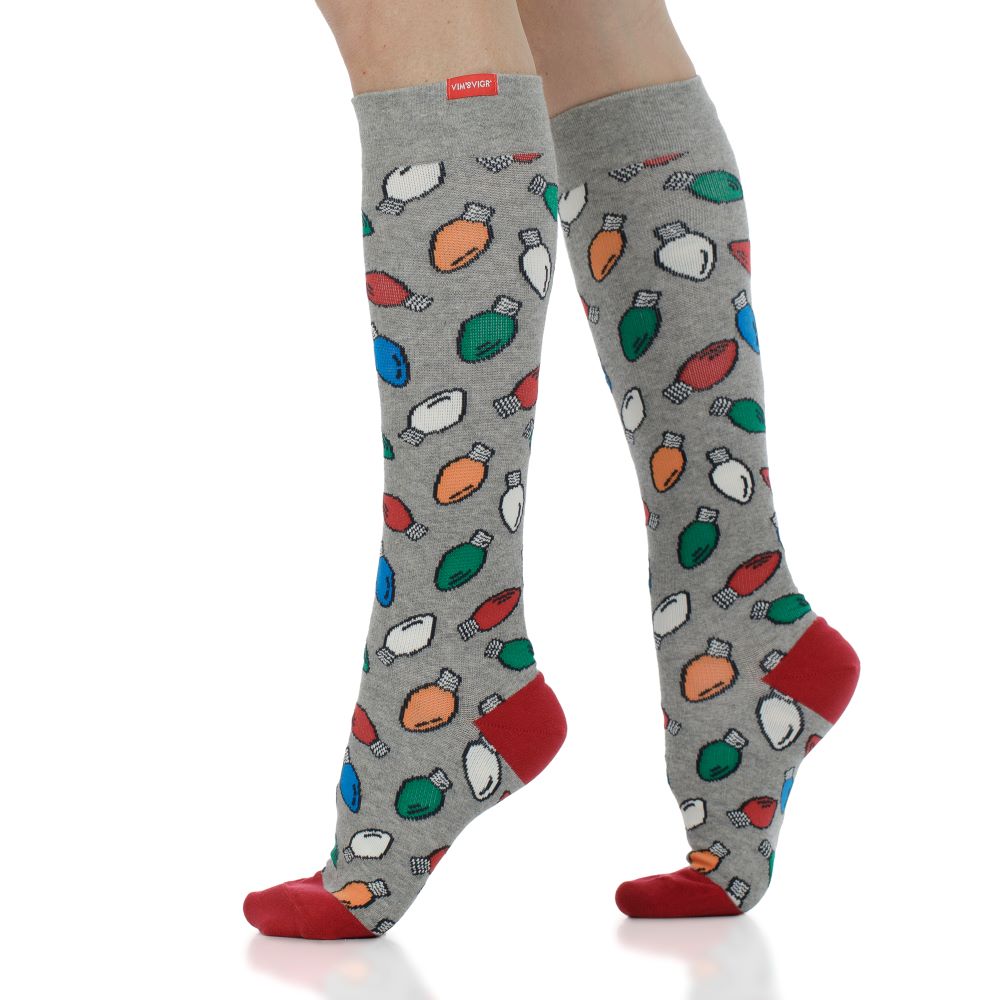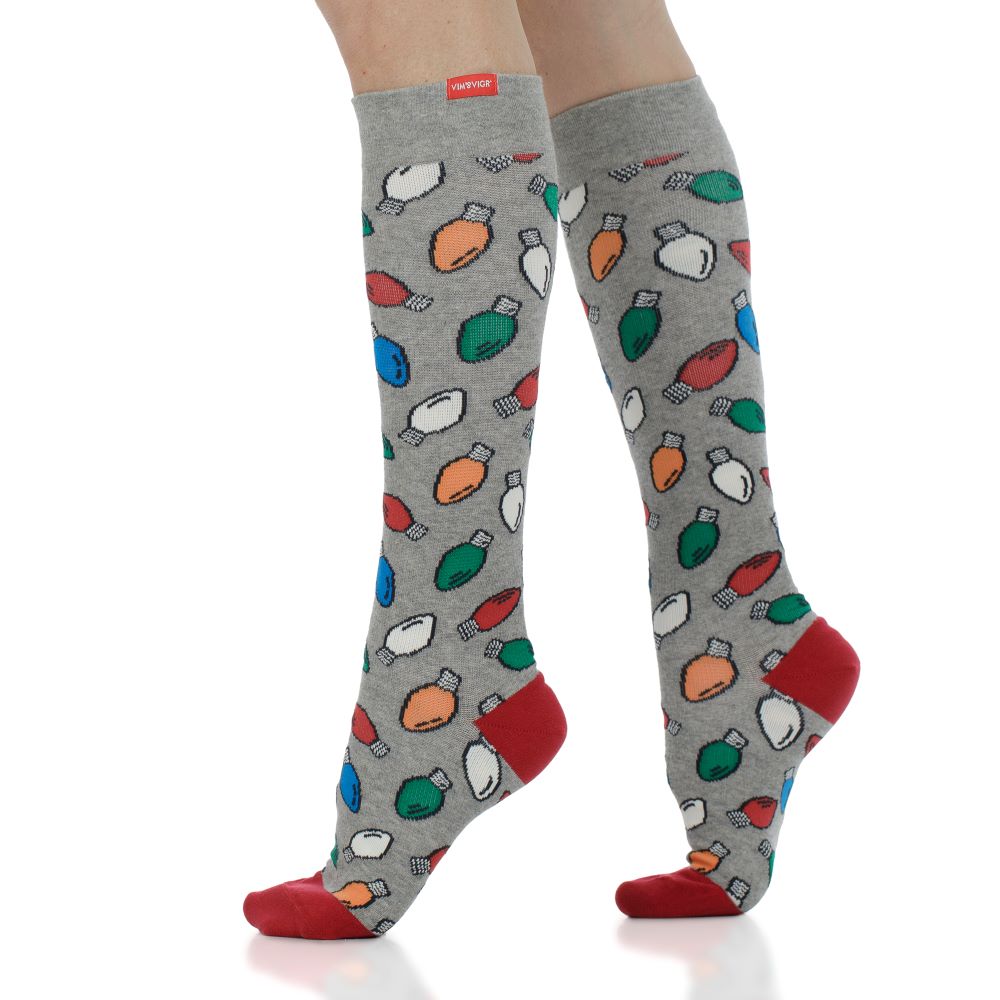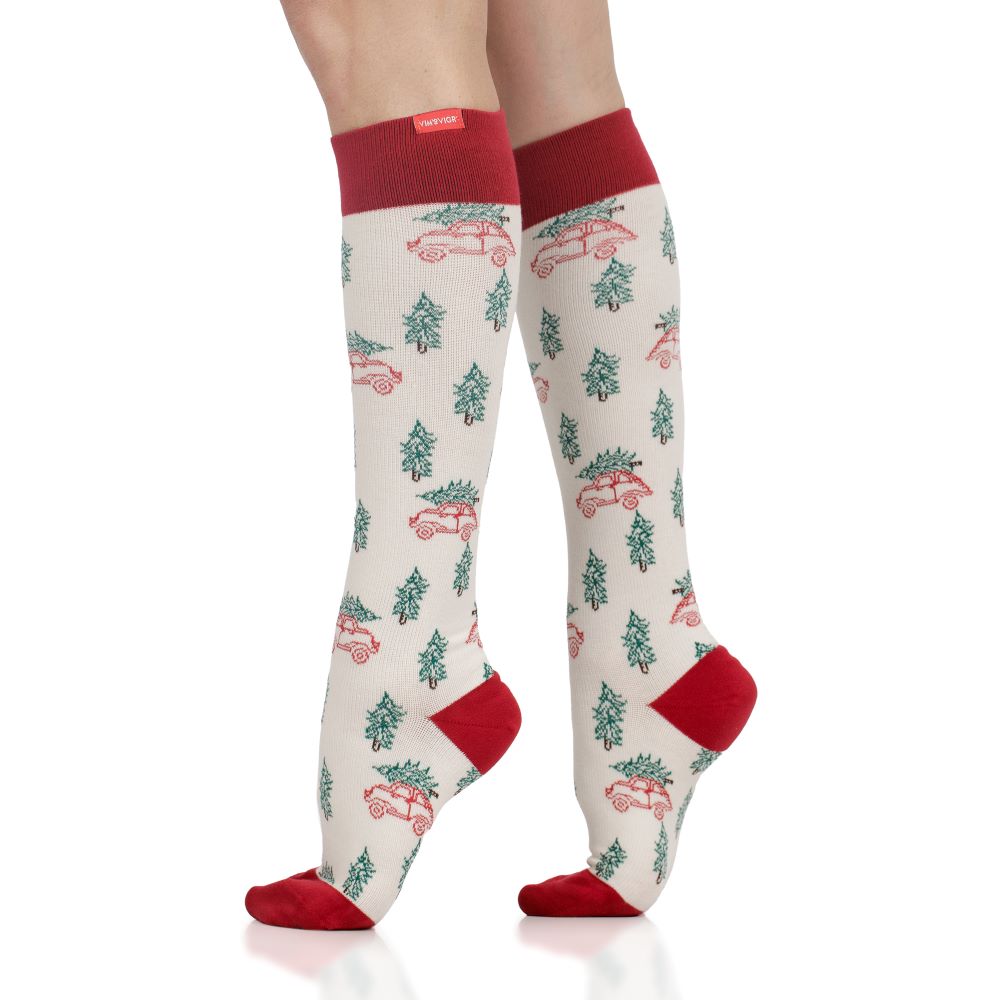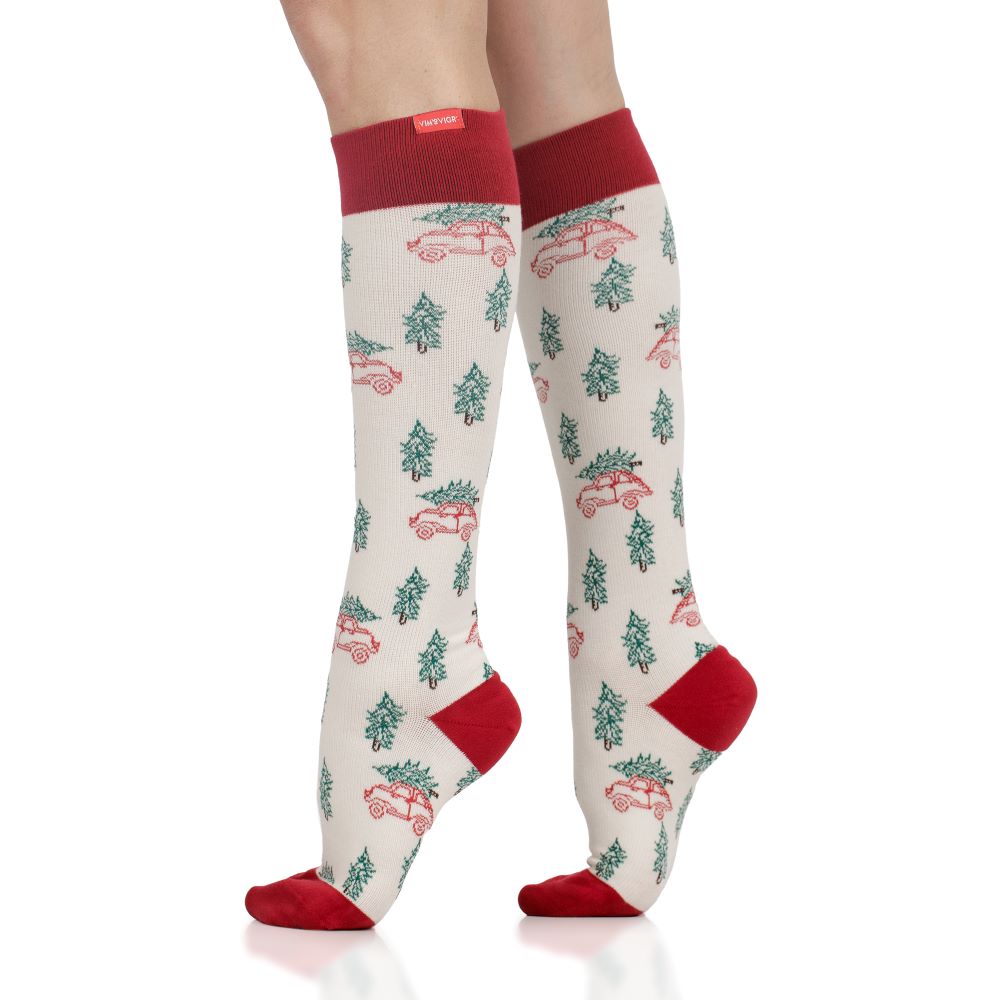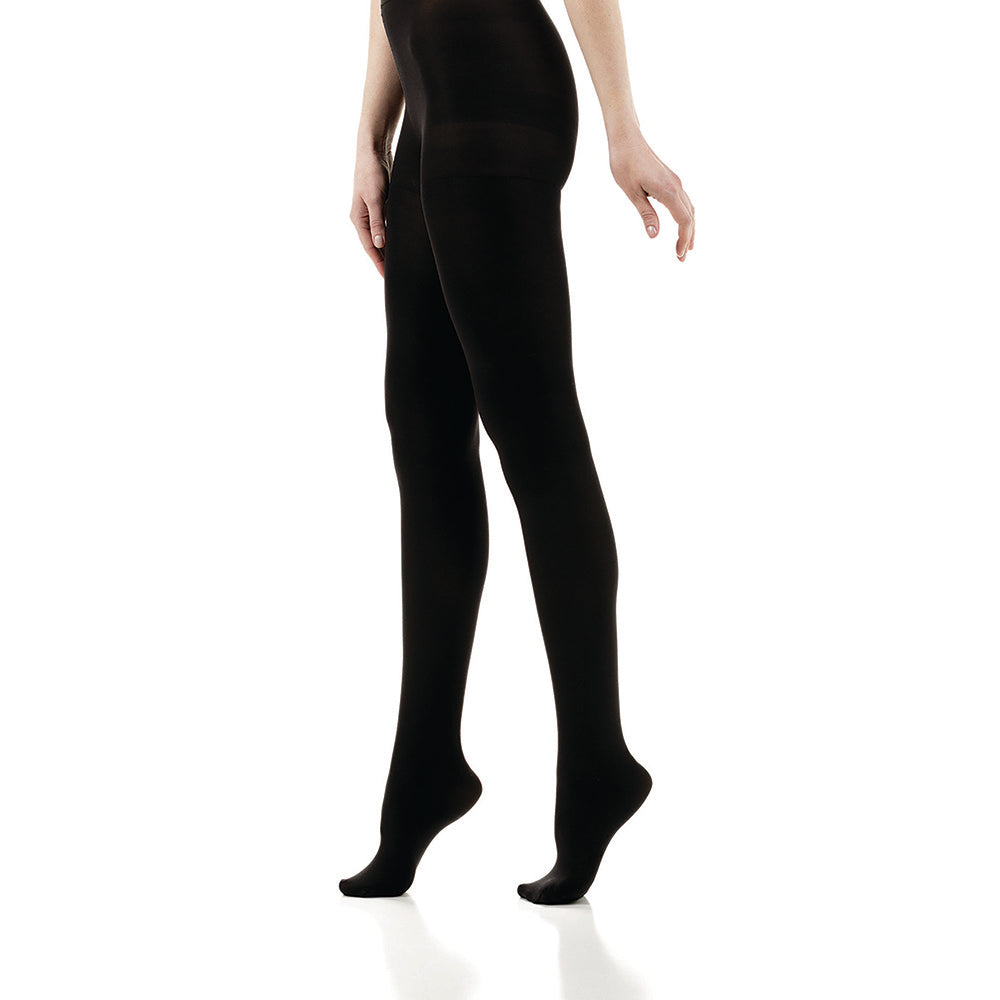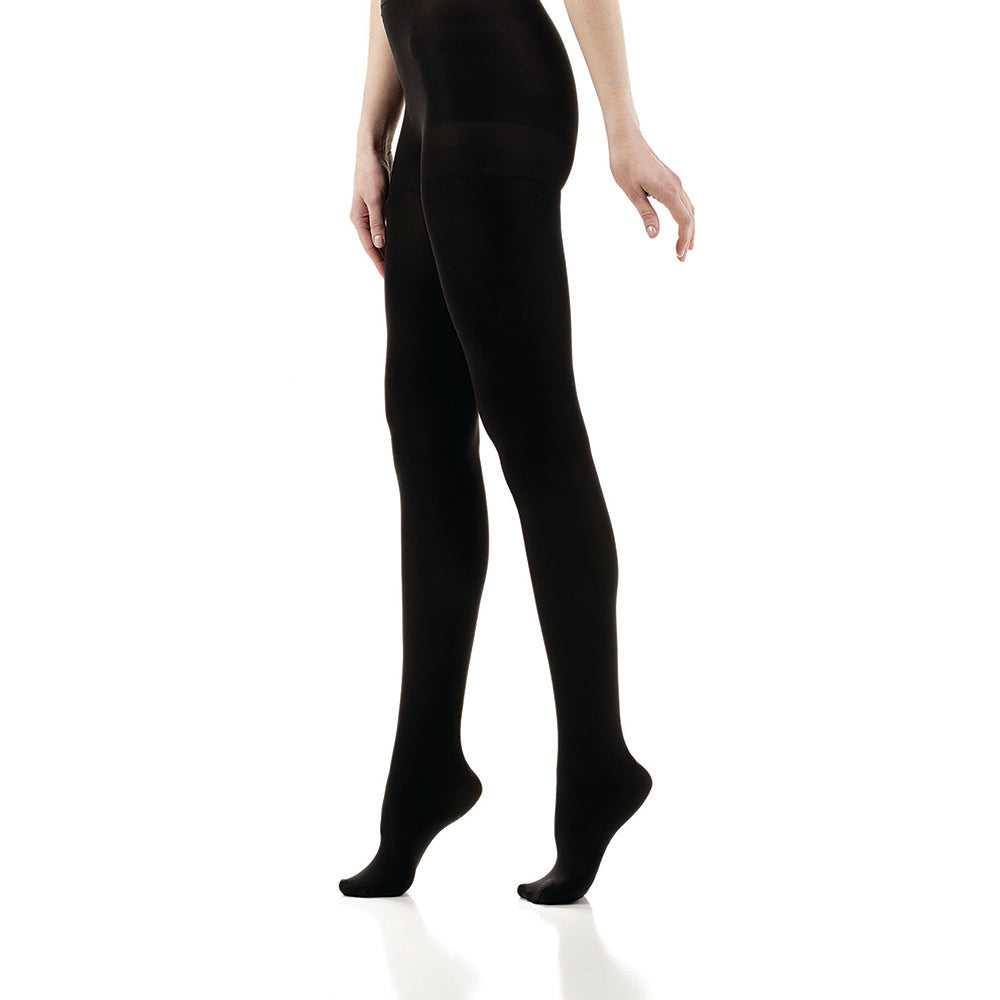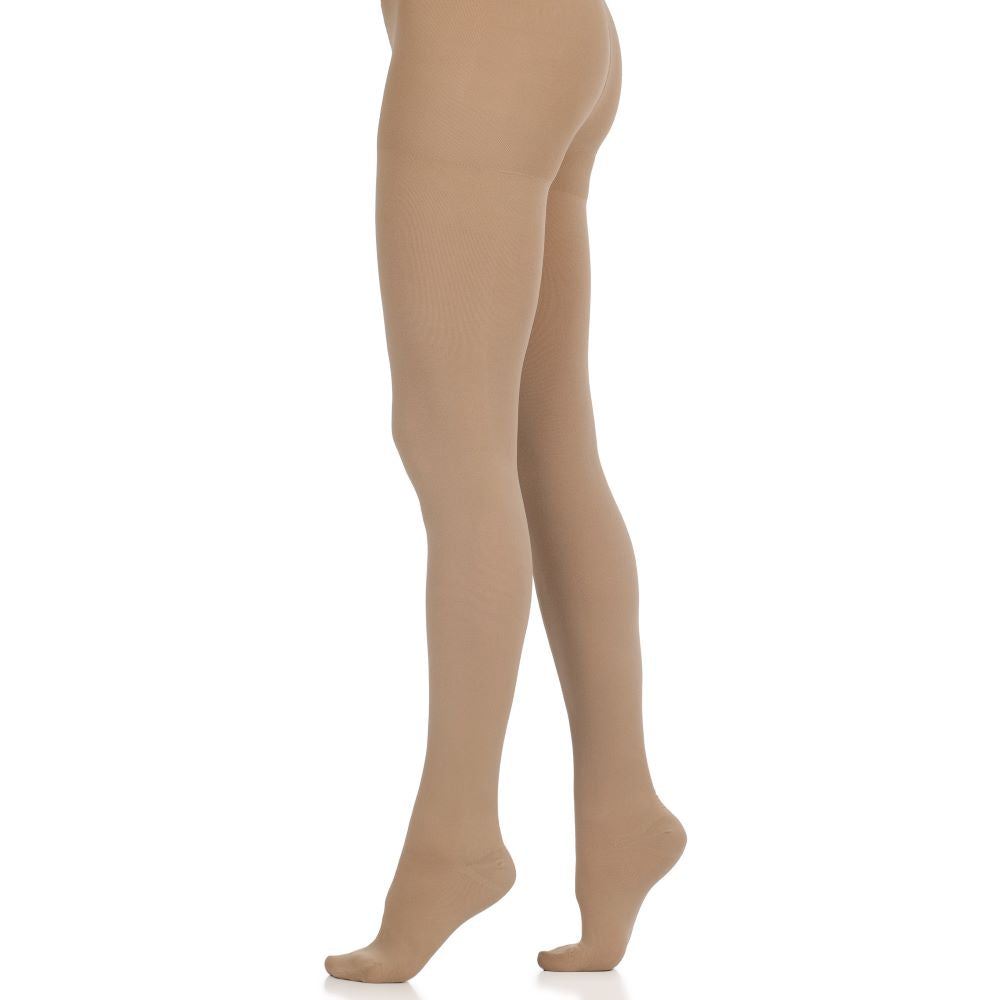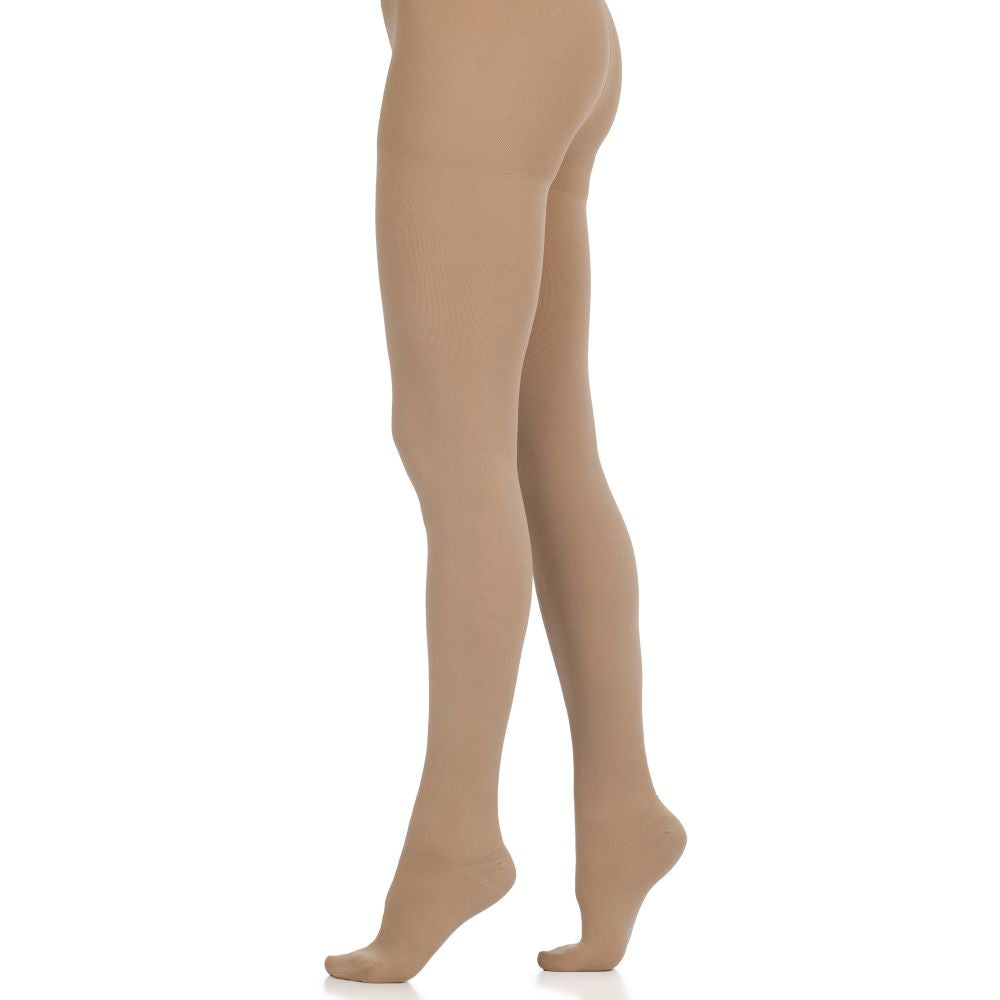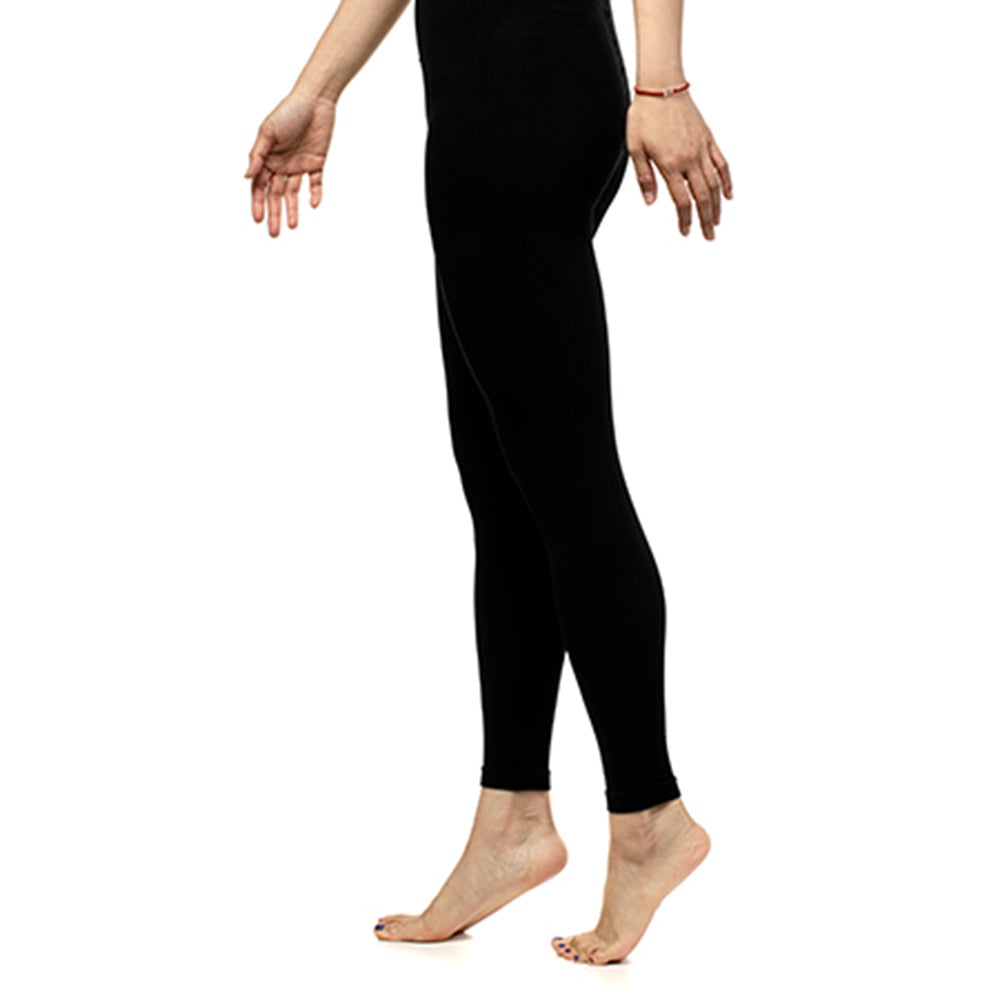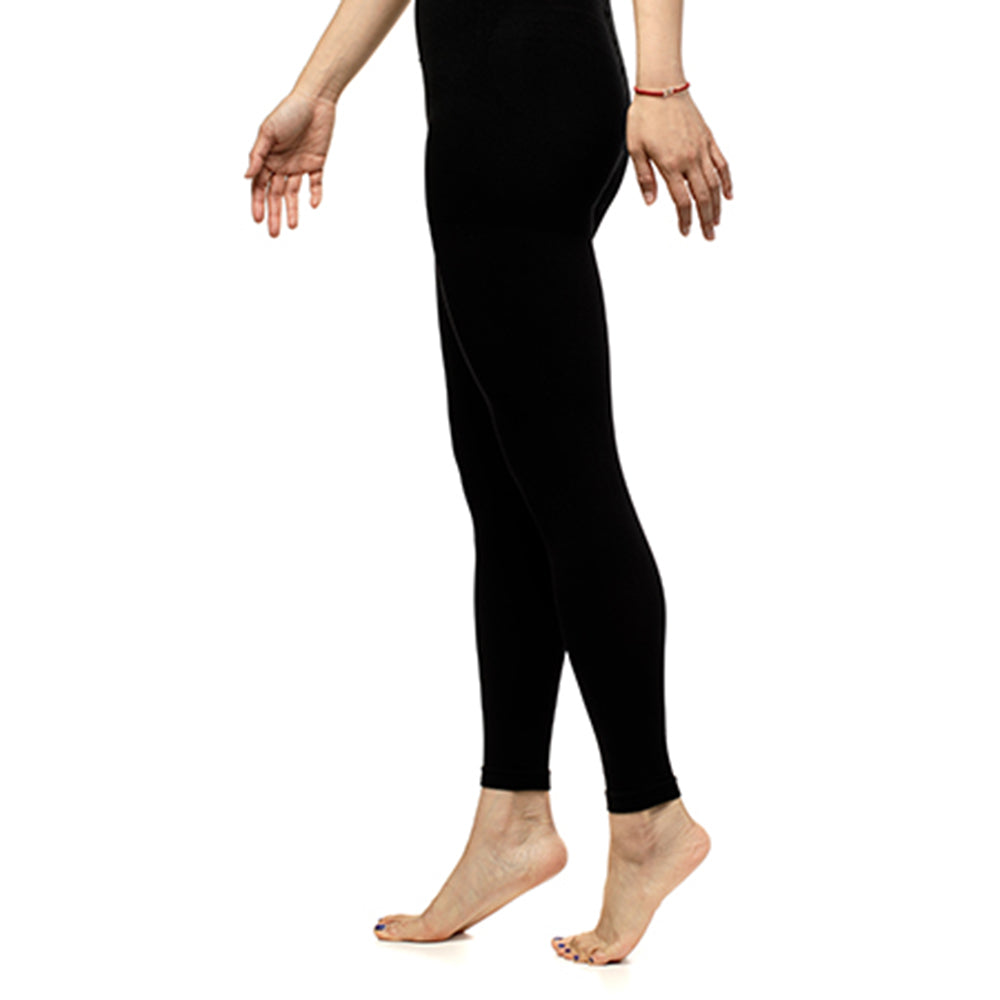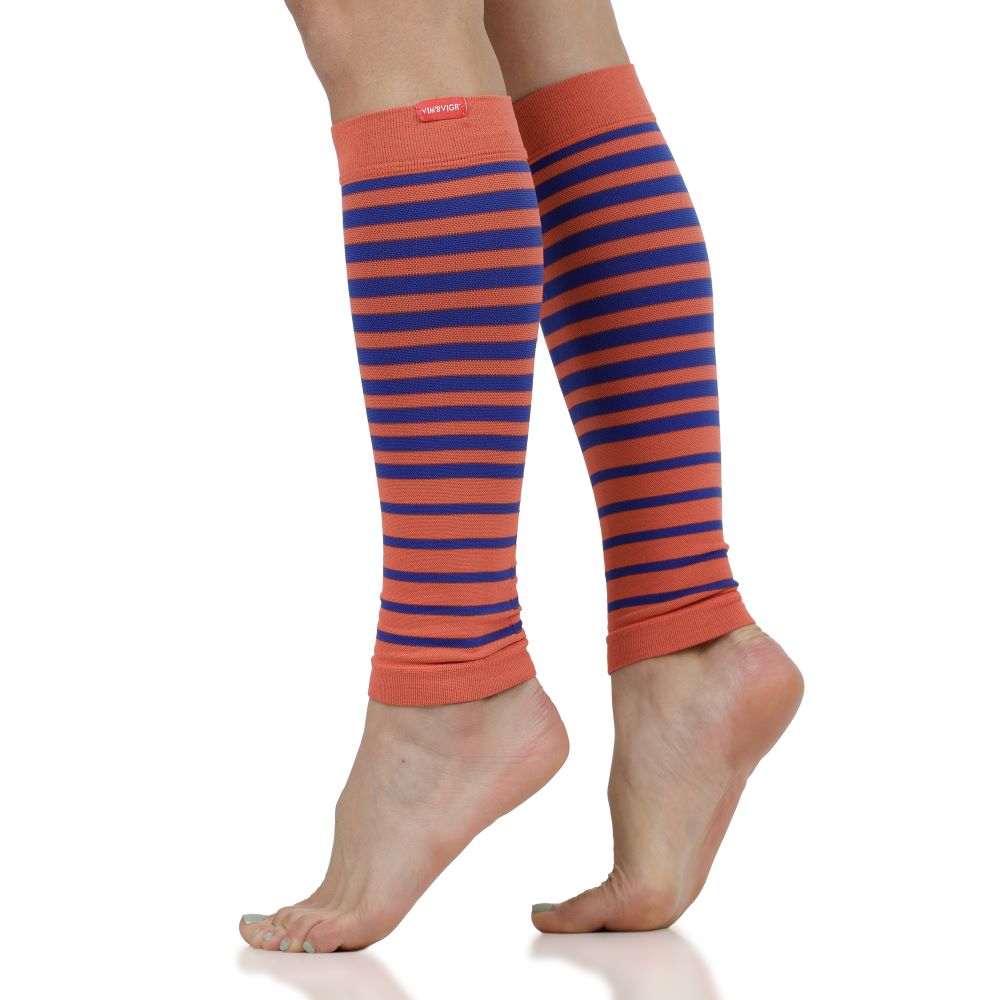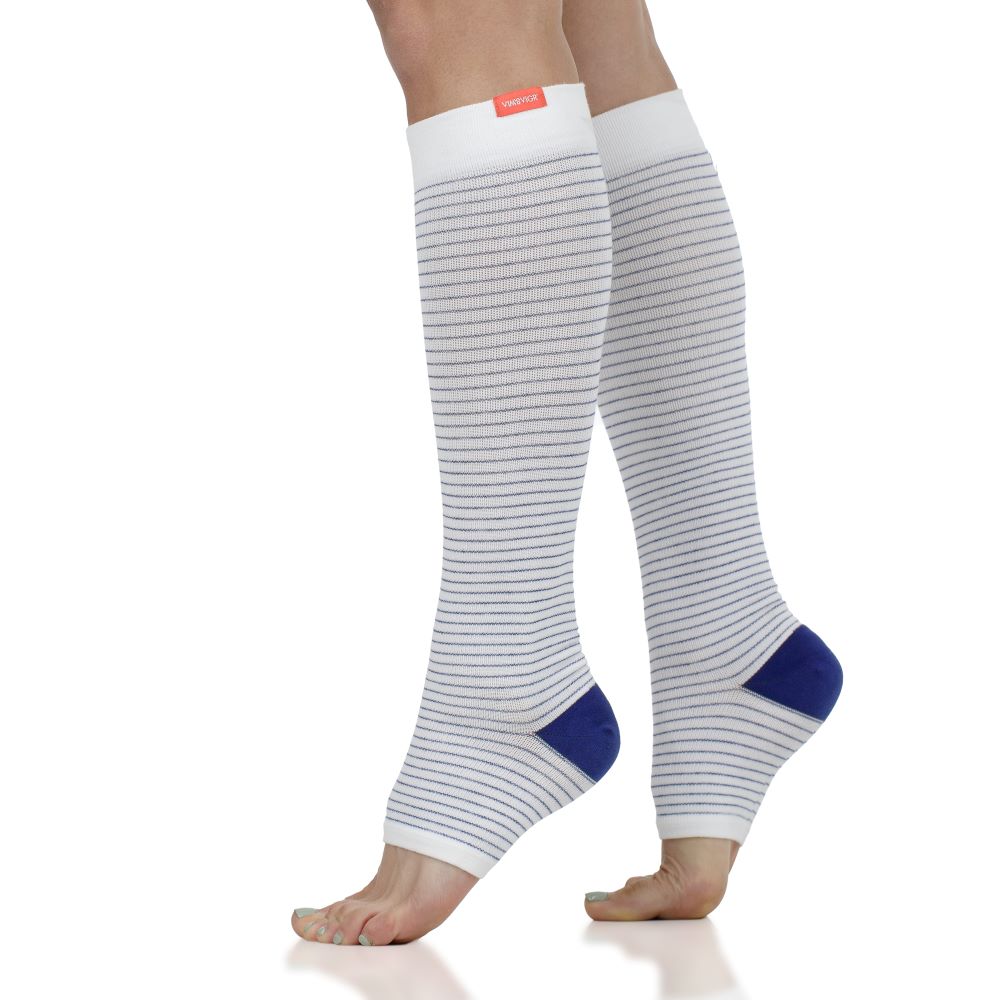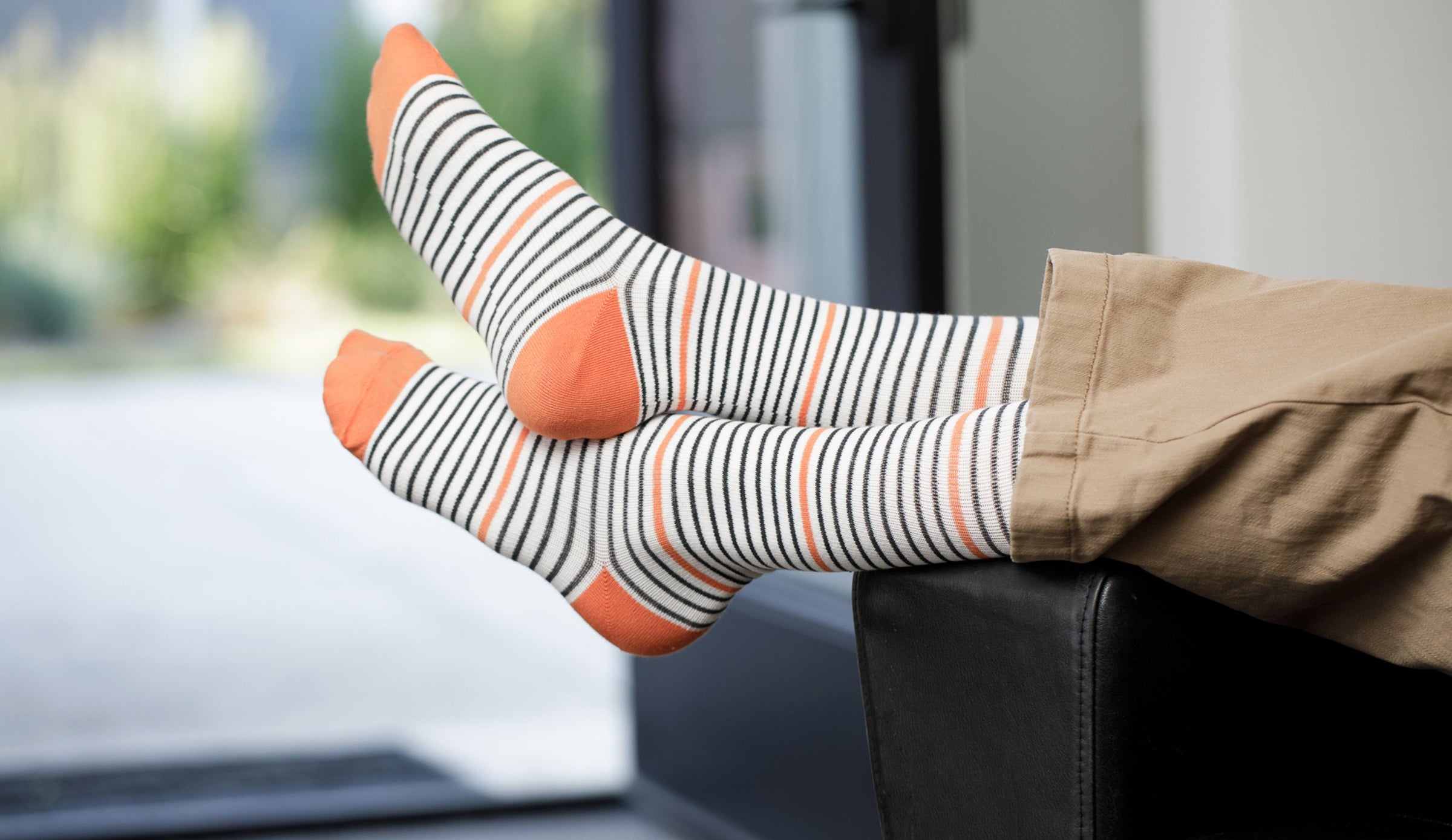
Women's Compression Socks
Written By Alecsa Stewart
Scientifically Reviewed by Daniel Chantigian
Do you suffer from swollen feet, tired and heavy legs, or simply sore legs for a long time after exercising? Our graduated compression socks and stockings for women offer you a solution to these problems while still being a fashionable item that can seamlessly blend with your outfits or even add an extra pop of color or style. Scientific research has shown that high-quality compression socks and stockings for women are a game changer that improves blood flow, which can improve your quality of life. Graduated compression socks can enhance peripheral circulation, reduce discomfort from swollen legs, relieve varicose vein symptoms, prevent deep vein thrombosis, and improve leg pain or discomfort, especially if you sit or stand all day for work.
With our line of Vim & Vigr compression socks for women, you get all the benefits of graduated compression therapy without sacrificing style. Our compression garments have options for four comfortable fabrics, three different compression levels (mmHg), and come in six different sizes. Whether you’re at work or working out, you can look and feel great in knee-high women's compression socks or full-length compression stockings.
Why Wear Compression Socks for Women?
Most women will wear compression socks to improve their peripheral circulation. They are recommended by medical researchers for improving leg circulation due to blood flow problems (such as varicose veins, blood clots, etc.) and for recovering after surgery, when lack of movement can affect peripheral blood flow. Additionally, our Vim & Vigr graduated compression socks are particularly effective at boosting upwards blood flow, as they are tighter at the ankles and looser towards the knees.
For active women, compression socks are an ally for improved performance and better recovery, according to this research article. Compression garments may also support the lower leg muscles, reducing the impact on the joints when you land on hard surfaces when walking or playing sports. Through the circulatory support they give your leg veins, compression garments can energize the legs, reduce feelings of muscular fatigue, and can help you recover quicker in between workouts.
Finally, pregnant women can benefit from wearing compression garments, as they offer additional support at a time where blood volume increases and adds pressure to the legs and blood vessels. Compression can boost circulation, increase comfort levels, and reduce the risk of complications during this period and beyond.
The Benefits of Women’s Compression Socks
From comfort to circulatory system health and muscular support, our Vim & Vigr compression socks for women provide a host of benefits. Here are the top ones.
Stay Energized During Long Workdays
If you sit or stand for long periods of time, without adequate movement, your lower legs can become swollen and sore. Gravity is one of the culprits involved as it causes blood to pool around the ankles, which can lead to blood clots or other complications. For office workers, wearing compression socks prevents the legs from becoming swollen or painful by ensuring the continuous flow of blood from the lower legs back to the rest of the body.
Those who stand a lot during work shifts, e.g. nurses, hairdressers, or teachers, have a similar problem when it comes to circulation out of the legs. Painful swelling and tired or heavy legs are common in these professions. Thankfully, graduated compression socks reduce the pressure on the lower legs, improve circulation, and offer a level of support to the calf muscles and shins. This will help you feel energized, improve your comfort, and help you get through your day without any discomfort!
Comfort and Improved Circulation During Pregnancy
During pregnancy, women often experience swelling and discomfort in the limbs because of the increase in blood volume traveling through the body. The added pressure on muscles and joints from changes during pregnancy are also common. Medical research has found that high-quality graduated compression socks and stockings can relieve some of this pressure, reduce leg swelling, and improve peripheral circulation.
Better blood flow for pregnant women is synonymous with lighter feet, less risk of varicose veins or blood clots, and no numb or tingly sensations. Because of their benefits, compression socks may also help pregnant women sleep better by eliminating pain or discomfort.
Postpartum Recovery
Postpartum compression tights or socks can offer new moms much needed circulation support and may provide pain relief in the legs, according to one study. Wear knee-high graduated compression socks to optimize your peripheral circulation, which can help prevent swelling and discomfort. When you return to exercising or standing for long periods of time, we recommend our compression tights which provide full-leg and pelvic / abdominal support.
Prevent Swelling and Fatigue While Traveling
When traveling on long-haul flights, there is an increased risk of peripheral circulation problems - especially blood clots and deep vein thrombosis. This also applies to any scenario where you spend a long time sitting without moving your legs, e.g. when driving on a road trip or traveling by train.
Researchers have found that graduated compression socks can prevent these problems. The CDC also recommends that travelers on long-haul flights get up regularly and move to keep blood flowing. You can do gentle stretches and exercises while seated as well. Our Vim & Vigr graduated compression socks provide improved peripheral circulation, while reducing your risk of blood clots or deep vein thrombosis while traveling.
Alleviate Menopause Related Discomfort
Menopause causes many changes in the body. One that you might not think about is that menopause causes an increase in fluid retention. This can increase your risk of varicose veins or other circulation problems. If you experience fluid retention during or after menopause, wearing compression stockings and socks may help. Particularly thanks to the graduated design that stimulates blood flow, our Vim & Vigr socks will help bring down swelling and inflammation in the lower limbs, which are common symptoms of lymphedema that occurs with menopause. Additionally, compression socks can protect the skin on the lower legs and support the muscles and joints to reduce discomfort.
Boost Athletic Performance and Speed Recovery
The improvements in circulation brought on by wearing compression socks may increase the efficiency and speed of delivering oxygen and nutrients to the muscles. Research has shown that graduated compression socks can reduce the time it takes to recover after workouts, improving athletic performance over the long term and reducing pain and discomfort over the short term.
Graduated compression socks also support the muscles and joints, reducing some of the impact of running or jumping. Compression socks can reduce the pain you may experience with DOMS (delayed onset muscle soreness).
Shin splints and Achilles tendinopathy are two of the most common running injuries. Wearing compression socks protects the lower legs to support the tendons and muscles while improving peripheral circulation. This might help reduce the impact of micro-vibrations on the muscles when running, reducing the risk of developing shin splints. Compression socks are also often recommended to runners recovering from these injuries, where added support to the joints is needed.
Post Surgery Recovery
If you’re bed-ridden post-surgery or have reduced mobility, you won’t be able to move your legs much. This can lead to severe health problems because of blood and fluid pooling in the limbs. To prevent this, medical professionals often prescribe compression socks. When recovering from surgery, wearing graduated compression socks can reduce the risk of complications like blood clots or deep vein thrombosis, according to this study. Also, they can help reduce swelling in your legs to make you feel comfortable all day and night.
Reduce the Risk of Varicose Veins
Women are more likely to get varicose veins because hormones tend to relax vein walls, according to the Mayo Clinic. For some, taking hormonal contraception increases this risk, while others may experience weakened veins because of pregnancy or the menopause. In all these cases, you can wear compression socks as a preventative measure, to support your leg veins and improve circulation.
Manage Swelling and Discomfort from Medical Conditions
Compression socks apply gentle therapeutic pressure to the lower legs, supporting blood flow and relieving pressure on the muscles and joints. This helps improve overall circulation, which can blood flow to your feet and lower legs to reduce the sensations of “pins and needles” that diabetes patients often experience. Moreover, the increase in blood flow helps reduce swelling and pain that often occur when someone is diabetic. Compression socks can prevent blood clots, ulcers, and infections for people with diabetes (protecting your lower legs from cuts and grazes, for example).
Additionally, as mentioned above, edema and lymphedema can occur when traveling long distance, during pregnancy or postpartum, or because of hormonal fluctuations. Wearing compression socks can be a great preventative tool against these, but also helps manage the symptoms and bring down swelling and inflammation.
Everyday Comfort and Fashion
Beyond reducing inflammation, swelling, and discomfort, compression socks can be a stylish fashion accessory. At Vim & Vigr, we ensure that our socks offer therapeutic compression without sacrificing your fashion. We offer a wide range of styles and designs. For giving you a pop of color with your outfit or blending seamlessly with a work dress, Vim & Vigr’s compression socks for women will give you your desired compression level, size, and style. And let us face it: who wants swollen ankles? A pair of high-quality, soft, and comfortable socks that also boost peripheral circulation are an everyday staple!
How to Choose the Best Compression Socks for Women
Choosing your best compression socks is easy. Follow our step-by-step guide:
Consider the level of pressure you need
Most first-time users of compression socks start with the casual 15-20 mmHg of compression, which is suitable for boosting circulation in all the scenarios we mentioned above. This gentle compression improves your comfort levels and offers decent support to the muscles and joints. You can increase it to 20-30 mmHg if you have some blood flow issues, or consult with your doctor to see if you need medical grade prescription-only 30-40 mmHg socks.
Consider the fabric
We offer compression socks in various materials to suit the activity levels and environments you’ll be wearing them in. Cotton is a great, versatile fabric for all-day wear, while merino wool is excellent for thermoregulation in either cold or hot weather. If you wear your socks to exercise, we recommend our nylon or moisture-wick nylon socks. And, if you want to make sure you won’t feel a seam, then go for the choice nylon collection.
Get the sizing right
Next, the size: you need your socks to feel tight so they’re boosting your circulation, but also comfortable enough to allow you full range of motion. Follow our sizing guide here and our instructions for putting and removing socks here so you can feel amazing in your pair.
How to Wear Women’s Compression Stockings
The reason Vim & Vigr women’s compression socks are a great choice is that they’re not only functional, effective, and comfortable - they are also extremely stylish, easy to wear with any outfit, and blend in seamlessly with your work, casual, or athletic wardrobe.
Our tips for wearing your socks to maximize benefits:
-
Always ensure you put them on correctly and that there are no folds or kinks in the material.
-
Wear your socks for increasing periods of time, as you get used to them (start with 2-3 hours for your first time, then gradually increase).
-
Wash your socks after every use with regular detergent (no bleach!) and let them air dry.
-
Rotate your socks for different colors and designs every day.
-
Choose compression sleeves or open toe socks if you need something different;
-
Wear your socks before a workout or run if you want a “warm-up” for your muscles, or afterwards for recovery.
-
For added support during your game, walk, run, or other physical activity, wear merino wool or moisture-wick nylon compression socks that improve comfort levels and keep feet dry.
Remember, always consult with your doctor if you have any questions or concerns, especially if you have a medical condition related to your heart or circulatory system.
References
Charles, T., Mackintosh, D., Healy, B., Perrin, K., Weatherall, M., & Beasley, R. (2011). Merino wool graduated compression stocking increases lower limb venous blood flow: a randomized controlled trial. Advances in therapy, 28(3), 227–237. Read it here.
Sachdeva, A., Dalton, M., & Lees, T. (2018). Graduated compression stockings for prevention of deep vein thrombosis. The Cochrane database of systematic reviews, 11(11), CD001484. Read it here.
Clarke, M. J., Broderick, C., Hopewell, S., Juszczak, E., & Eisinga, A. (2021). Compression stockings for preventing deep vein thrombosis in airline passengers. The Cochrane database of systematic reviews, 4(4), CD004002. Read it here.
Amsler, F. & Blattler, W. (2008). Compression therapy for occupational leg symptoms and chronic venous disorders: a meta-analysis of randomised controlled trials. Database of Abstracts of Reviews of Effects (DARE): Quality-assessed Reviews [Internet]. York (UK): Centre for Reviews and Dissemination (UK). Read it here.
Kakkos, S. K., Timpilis, M., Patrinos, P., Nikolakopoulos, K. M., Papageorgopoulou, C. P., Kouri, A. K., Ntouvas, I., Papadoulas, S. I., Lampropoulos, G. C., & Tsolakis, I. A. (2018). Acute Effects of Graduated Elastic Compression Stockings in Patients with Symptomatic Varicose Veins: A Randomised Double Blind Placebo Controlled Trial. European journal of vascular and endovascular surgery: the official journal of the European Society for Vascular Surgery, 55(1), 118–125. Read it here.
Phillips, S. M., Gallagher, M., & Buchan, H. (2008). Use graduated compression stockings postoperatively to prevent deep vein thrombosis. BMJ (Clinical research ed.), 336(7650), 943–944. Read it here.
Mota, G. R., Simim, M. A. M., Dos Santos, I. A., Sasaki, J. E., & Marocolo, M. (2020). Effects of Wearing Compression Stockings on Exercise Performance and Associated Indicators: A Systematic Review. Open access journal of sports medicine, 11, 29–42. Read it here.
Guedes, P. M., Saldanha, N. A., Matos, P. M., Carvalho, F. S., Veiga, G., & Norton, P. (2020). Occupational leg edema-use of compression stockings. Porto biomedical journal, 5(6), e093. Read it here.
Saliba-Júnior, O. A., Rollo, H. A., Saliba, O., & Sobreira, M. L. (2022). Positive perception and efficacy of compression stockings for prevention of lower limb edema in pregnant women. Jornal vascular brasileiro, 21, e20210101. Read it here.
Jamieson, R., Calderwood, C. J., & Greer, I. A. (2007). The effect of graduated compression stockings on blood velocity in the deep venous system of the lower limb in the postnatal period. BJOG: an international journal of obstetrics and gynaecology, 114(10), 1292–1294. Read it here.
Mosti, G., Picerni, P., & Partsch, H. (2012). Compression stockings with moderate pressure are able to reduce chronic leg oedema. Phlebology, 27(6), 289–296. Read it here.
Rother, U., Grussler, A., Griesbach, C., Almasi-Sperling, V., Lang, W., & Meyer, A. (2020). Safety of medical compression stockings in patients with diabetes mellitus or peripheral arterial disease. BMJ open diabetes research & care, 8(1), e001316. Read it here.
